UP’s villages might vote again on caste and religion. But what they desperately want: clean water.
Clean and available water has never been a dominant election issue for any party in Uttar Pradesh, despite some of the worst indices in the country. A month from the start of a seven-phase election in India’s most populous state Uttar Pradesh, Gaon Connection travels to villages to explore the issues that affect the daily lives of the rural citizens.

Sitapur and Lakhimpur Kheri, Uttar Pradesh
Assembly elections in India’s most populous state Uttar Pradesh with over 200 million people – which is nine times the population of the Australia continent – are scheduled to be held from February 10 to March 7 in seven phases. Almost 78 per cent (155 million people, as per the 2011 census) of the state’s population lives in rural areas, where access to clean drinking water remains a challenge.
“In the past five years, no one has come to address our water woes. The politicians come asking for votes but none of us has been provided a tap water connection,” Shiv Bhole Yadav, a resident of Dhaurahra village in Khambarkhera gram panchayat in Lakhimpur Kheri district, told Gaon Connection.
“We have only community handpumps, which give very poor quality water. We have been drinking this water for the past sixteen years,” said Shiv Bhole.
Only 13.22 per cent of rural households in Uttar Pradesh have been provided with tap water supply, which is the lowest in the country, shows the data of the central government’s Jal Jeevan Mission, which is implementing the ‘Har Ghar Jal’ scheme to provide tap water connections to all households in the country.
In short, 86.78 per cent of the rural families in Uttar Pradesh – that is 22.9 million village households – depend on handpumps or other private means of water supply. The state has a target of cent per cent tap water connection coverage by 2024 across all its rural households in 97,000 villages.
Despite the low coverage at 13.22 per cent, Chief Minister Yogi Adityanath-led government seems confident of meeting the 2024 deadline.
“The work done under the scheme is unprecedented and no other political party has ever been so successful in providing tap water connections to the rural citizens,” Shalabh Mani Tripathi, Uttar Pradesh Chief Minister’s media advisor, told Gaon Connection. The scheme’s implementation will be completed within the declared time frame, he added.
According to an official statement, the Uttar Pradesh government provided 1.915 million tap connections in 2020-21. In the financial year 2021-22, the state has planned to provide 5.9 million tap water connections. In 2022-23, the aim is 8.54 million tap water connections while in 2023-24, the final nine million taps will be provided.
Villagers who have got a tap water connection claim their lives have transformed. “Earlier, we used to fetch water from a nearby well at least a hundred times a day because we also had to provide water to our cattle. Now with a tap at our home, we easily get water and use it for cooking and bathing, also,” Kallu, a resident of Basari village in Barabanki district, told Gaon Connection.
“It was the summer of 2019 when a paani ki tanki (water tank) was set up in our village and eighty households were provided tap water connections,’ informed Kallu, who said the villagers were now supplied water seven hours a day – from 6am to 9am in the morning, then 1pm to 3pm in the afternoon, then 6pm to 8pm in the evening.
The long wait for water
Over 150 kilometres away, Mohini Devi can’t wait to get the promised tap water connection. “Paani nahi hai, karuva tel hai yeh,” she lashed out as she sat on her haunches, next to a rusted handpump in her village in Khambarkhera gram panchayat, scrubbing vessels with ash. The acrid mustard oil is locally known as karuva tel, or bitter oil.
“The handpump is our only source of water and it throws out yellowish colour, smelly water. Heek det hai (It smells). But we drink and cook with it,” the 40-year-old resident of Lakhimpur Kheri district, told Gaon Connection.
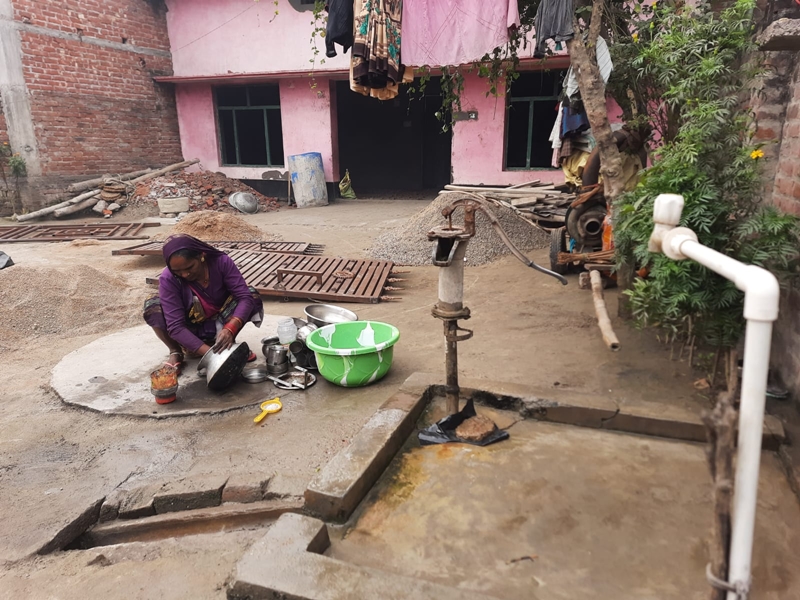
In the neighbouring district of Sitapur, Sunita Devi, a mother of five, who was recently widowed, also depends on an old cast iron handpump to meet the water needs of her family.
“Peeliya se maut ho gayi [jaundice killed him],” Sunita, a resident of Rai Maror village, told Gaon Connection referring to her husband’s death. The doctors, she said, told her that peeliya is caused due to drinking contaminated water. The 45-year-old complained that the handpump, her family’s only source of water, pumped out ‘peela paani’ (yellow coloured water).
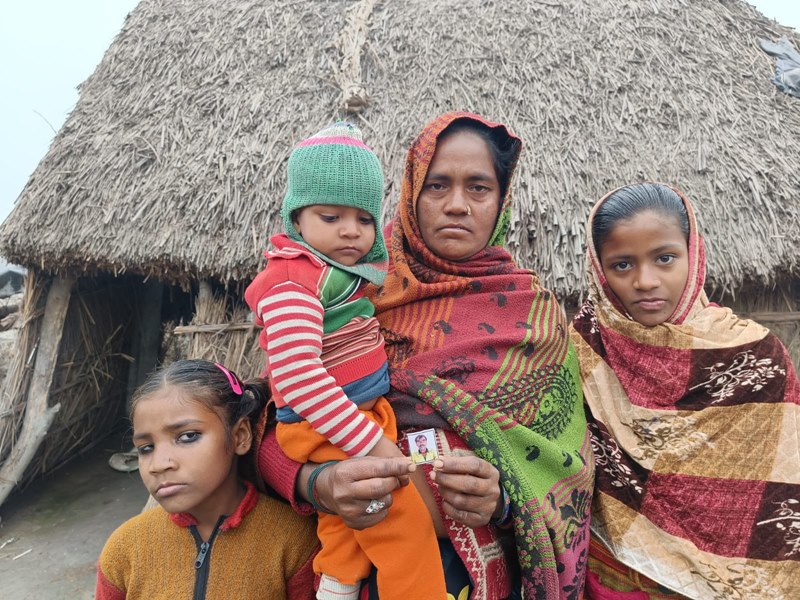
As per the official data of the Jal Jeevan Mission, only 3.03 per cent of the rural households in Sunita Devi’s Sitapur district have tap water connections. Mohini Devi’s Lakhimpur Kheri district is a notch better with 15.96 per cent coverage.
Elections are here and predictably, political accusations fly thick and fast.
“This Har Ghar Jal scheme has been consumed by corruption ever since its inception. Right from water taps to pipes, corruption hasn’t spared any aspect of this scheme,” Anand Bhadauria, Samajwadi Party spokersperson, told Gaon Connection.
Commenting on the target of 100 per cent coverage by 2024 Bhadauria said “there was zero possibility of the mission meeting its target in the stated period. The condition of drinking water supply is in shambles in rural Uttar Pradesh”.
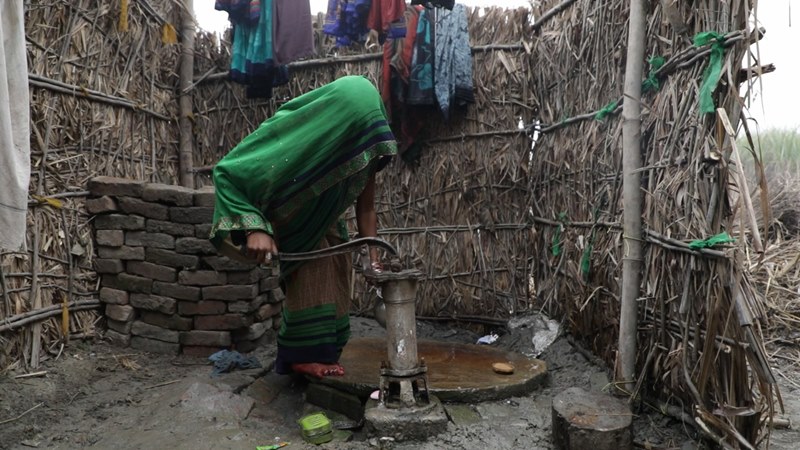
However, leaders of the ruling party BJP claim the work done under the tap water supply scheme was unprecedented.
“Before our scheme, nobody had even thought of providing tap water to every household. Previous governments considered it natural for villagers to fetch water from local ponds and government taps,” Manish Shukla, a local BJP (Bharatiya Janata Party) leader from Sitapur where tap water connection coverage is 3.03 per cent, told Gaon Connection.
“Sometimes it’s the floods that impede the progress of the project, Corona has been hampering development projects for two years now,” the BJP leader added.
Water sector experts acknowledge the challenges in Uttar Pradesh. “This (Jal Jeevan Mission) is a very ambitious scheme and the time allotted to complete it is very limited. UP in itself, if it was an independent country, would have been the fifth largest populated country in the world,” Lucknow-based Farrukh Khan, regional manager, WaterAid India, told Gaon Connection.
Jal Jeevan Mission
Launched in 2019, the central government’s Jal Jeevan Mission has so far provided tap water supply to 45.68 per cent of the rural households across the country.
Goa (poll bound like Uttar Pradesh), Telangana, Andaman & Nicobar Islands, Puducherry, Dadra and Nagar Haveli, Daman and Diu, and Haryana have achieved 100 per cent tap water coverage under the scheme, shows the official data.
Map 1: Rural tap water coverage in states/UTs as of January 11, 2022

Of the total 75 districts in Uttar Pradesh, 66 districts have less than 25 per cent of tap water connections.
Baghpat has the highest tap water coverage at 43.44 per cent, whereas Sunita Devi’s district Sitapur has the lowest coverage at 3.03 per cent.
Map 2: District-wise rural tap water coverage in UP as of January 11, 2022

At present, the state government has prioritised functional tap water connections to regions affected by poor water quality, especially those areas prone to Japanese Encephalitis and Acute Encephalitis outbreaks, and drought prone areas of Bundelkhand and Vindhyachal. The government claims it is confident of meeting the 2024 deadline of providing tap water connections to all households.
Also Read: Also Read: ‘It is poison, not water, that comes out of the handpumps’
Poison in the water
Tap water coverage aside, the quality of water remains a big issue in Uttar Pradesh. The water in several districts is contaminated by arsenic, fluoride and iron, which cause serious health problems including cancer (arsenicosis).
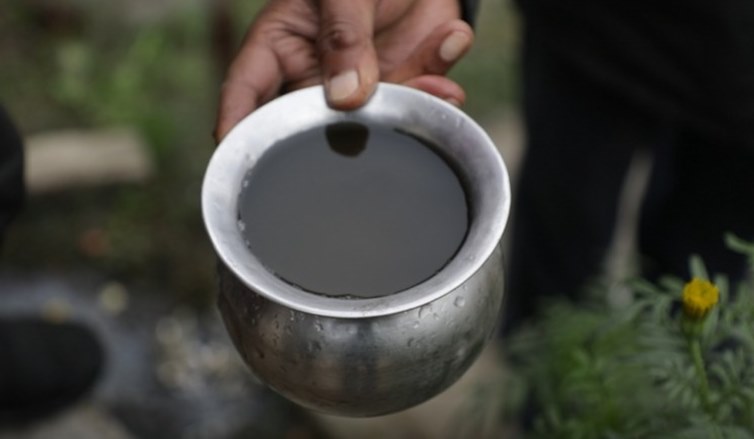
The 2019 data of the Department of Drinking Water and Sanitation shows that 63 of the total 75 districts in Uttar Pradesh have fluoride above the permissible limit of 1.5 milligram per litre (mg/l). Further, 25 districts are affected by high arsenic (above 0.05 mg/l).
Almost 18 districts, including Sitapur and Lakhimpur Kheri, have both high arsenic and fluoride in their groundwater. Millions across the state are having to drink a cocktail of poison.

“High fluoride causes fluorosis that can harm teeth, bones, and lead to disability. Also it causes severe nutritional disorders. High arsenic causes arsenicosis that leads to black skin spots. Arsenic is highly carcinogenic,” Gujarat-based Sunderrajan Krishnan, who works with India Natural Resource Economics and Management (INREM) Foundation, told Gaon Connection. INREM Foundation works to minimise the impact of water-borne diseases.
Similar concerns are raised by Venkatesh Dutta, Lucknow-based, river and environmental scientist, “Consuming water with high concentration of fluoride for an extended time period causes adverse health effects such as skin lesions, discoloration, cardiovascular disorders, dental and skeletal fluorosis.” Arsenic can even cause cancer if exposure is for long periods, he warned.
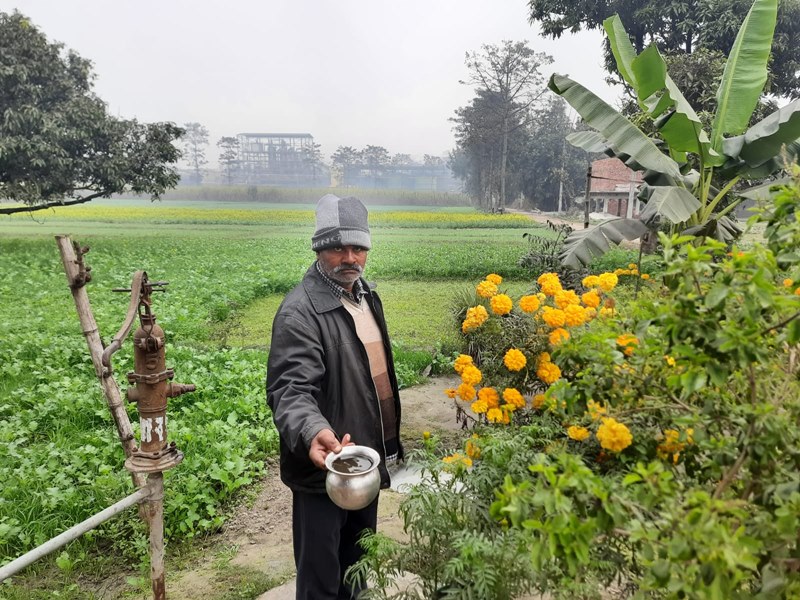
There are 70-80 community handpumps for the 12 villages under Khambarkhera gram panchayat in Lakhimpur Kheri district, said Bahori Lal, the gram pradhan. The gram panchayat has more than 1,500 households and 4,700 voters. All have no option but to drink poor quality water, he added.
Sickness in each drop
According to the World Health Organization (WHO), contaminated water and poor sanitation are linked to transmission of diseases such as cholera, diarrhoea, dysentery, hepatitis A, typhoid, and polio.

In India, about 37.7 million people are affected by waterborne diseases every year and 1.5 million children die of diarrhoea.
Between 2013 and 2017, water-borne diseases — cholera, diarrhoea, typhoid and viral hepatitis — caused 10,738 deaths in India. About 60.6 per cent (6,514) of all deaths were caused due to diarrhoea. This data was shared in Lok Sabha by the then Union health minister Jai Prakash Nadda, on April 6, 2018. Uttar Pradesh recorded the most diarrhoeal deaths — 22.21 per cent – in the same period.
“People here continue to suffer from jaundice, fever, typhoid, and skin rashes. My son had typhoid and the doctor said it was due to drinking kharab paani (contaminated water),” Pushpa Devi, a resident of Dhaurahra village in Phool Behar block of Lakhimpur Kheri told Gaon Connection.
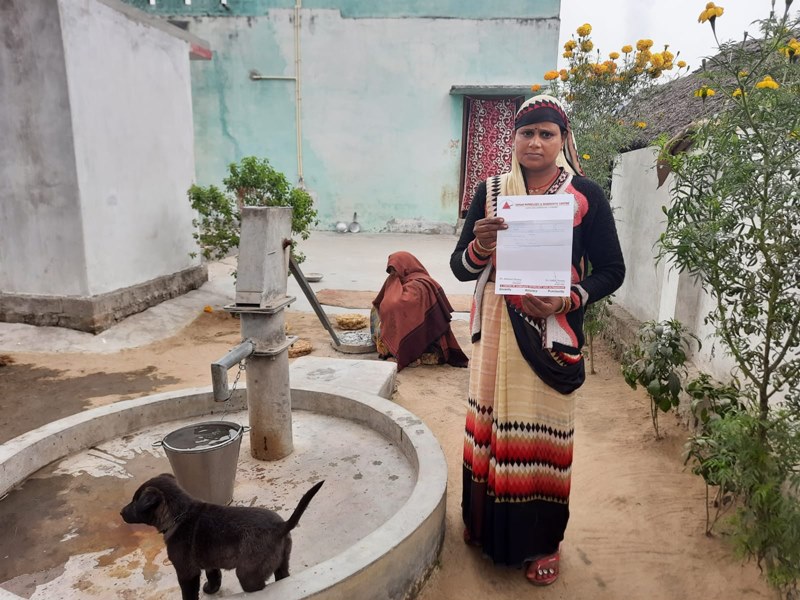
“We have seen cases of typhoid, diarrhoea, dysentery, jaundice and skin diseases in this area,” Manoj Kumar, medical officer at the Community Health Centre, Tambour, Sitapur told Gaon Connection. “We suspect this is due to the daily consumption of contaminated water. Heavy metals in water can damage the kidney,” the doctor added.
“These cases of water-borne diseases increase during monsoon and floods when the region remains waterlogged for months,” the medical officer said. “Villagers should boil water before drinking. Those who can afford to, should use water filters,” he suggested.
Flush with funds
A press statement dated August 6, 2021 issued by the Ministry of Jal Shakti, shows the total assured fund available for the implementation of Jal Jeevan Mission in Uttar Pradesh is more than Rs 235 billion.
The central government allocated Rs 108.7 billion to the state under the Jal Jeevan Mission for 2021-22. This was the highest allocation so far to any state, stated the Ministry of Jal Shakti in its statement dated June 12 last year.
According to the state government, the tap water scheme’s implementation in Uttar Pradesh will be completed within the declared time frame (2024), assured Shalabh Mani Tripathi, media advisor to the CM Adityanath.
With inputs from Pratyaksh Srivastava, Lucknow.

